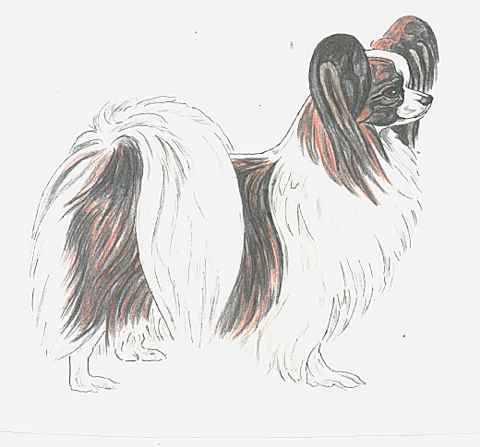

| ©2005 Ms D E Ashdown |
| (You are not permitted to copy any illustrations from this site - please note copyright warning on Home Page) |
|
This template
depicts a handsome, striking Red Sable/White Papillon which is very
slightly longer in body than height at shoulder, (but not by much.) He
has a beautiful, flowing, correct coat The head markings are identical
in each drawing - the only change is in the body markings. Some
versions show a darker red sable and white colouring, some a lighter
shade. This template is intended to demonstrate flattering and
unflattering markings, and the optical illusions some markings can
create.
Another purpose of
this - as with many templates in the Complete Illustrated Standard - is
to stimulate discussion and thinking. You may not agree that these 9
versions of the same template do create the illusions we have
described in the text. You may think they create quite different
impressions on the eye. What is certain is that the some of the 9
versions look very different from some of the others.
All types of body
markings are acceptable, according to all four Standards. This sequence
of drawings simply compares some markings with others and invites
comparisons from the reader and viewer. Optical illusions are a
reality, and sometimes need to be overcome in order to appreciate a dog
on its real merits. Ideally, they are overcome very quickly.
|
|
|
|
|
| A | B |
|
A
shows the dog without any body markings at all, just the head marking
with its full white blaze and white muzzle. You might think he looks
square, or even a little tall. This is an optical illusion caused by the
total lack of body colour.
B
shows a marking which is very flattering to any dog, of any breed,
whether he has a good neck and shoulders (as this dog has) or whether he
has a short neck and stuffy shoulders. This is the "shawl"
marking, which more or less follows the outline of the shoulder
placement and which is also very glamorous and showy. In this version,
the white collar is relatively narrow.
|
|
 |
 |
| C | D |
|
In
C the "shawl" marking is, if anything,
even more flattering for it descends to the brisket most gracefully, and
the neck, lacking the red sable patch behind the head, forms a full,
wide ,white collar.
Note how, in
B and C,
the very shadings of the sable colour - essentially black tips on a base
colour - add to the pretty effect of the "shawl"
D is a version
showing a "blanket" body marking. Here, the patch of colour begins at
the shoulder and extends right to the base of the tail. The colour also
descends to the full extent of the dog's undercarriage featherings and
to the same level down his right hind leg. This probably is not anyone's
favourite marking, as it gives the impression of a big, oblong patch
planted on the side of the dog. But this does not matter particularly -
what matters is that the topline appears to rise from shoulder
to root of tail. In fact, it does not - it is the red sable marking
that rises up.
|
|
 |
 |
| E | F |
|
E is quite a dark dog, this deep, rich
red sable colour is most dramatic. The dog's markings are nicely
balanced and he has a flattering narrow white collar. The point of this
version, however, is that the sable marking stretches almost to the full
extent of the chest hair (frill) then falls away steeply in a right
angle. This marking, combined with the patch of colour on the
hindquarters, creates the impression that the dog is rather longer than
he actually is (compare with A) On
the other hand, his good neck and shoulders are drawn attention to far
more effectively than A.
F is patched very irregularly. It is
the long, narrow band of colour on his hindquarters that makes him look
rather unbalanced, however, since the markings on his forequarters are
well broken up.
|
|
 |
 |
| G | H |
|
G looks rather too high on the leg,
solely because all the body colour is concentrated upon the upper half
of his body. To add to the effect, he does not have a white collar -
the sable colouring continues relentlessly from his head to his tail.
H is similar, but these markings look
much better on first impression, because the dog has a white collar and
because he is lighter in colouring. In addition H's sable markings
occupy a smaller area of his body. Many a dog has been unfairly
penalised in the ring through the combination of heavy blanket markings
and a very dark colour, because the combination creates an
optical illusion of size. In other words, not only will he stand out
like a sore thumb against his more lightly-marked competitors, he will
look bigger (even if he is not).
|
|
|
|
|
|
I |
|
|
I
looks very similar indeed to D. The
difference is that although the big, broad sable patch is evenly
finished on his hindquarters, descending harmoniously to the ground,
the jagged, irregular edges at his shoulders and chest give the
impression that he is out at elbow.
I is
only one example of markings that give the wrong impression of a dog's
construction; we could have gone on almost indefinitely on this theme.
Markings are sometimes the bane, and sometimes the delight, of all
breeders and exhibitors of patched dogs.
|
|